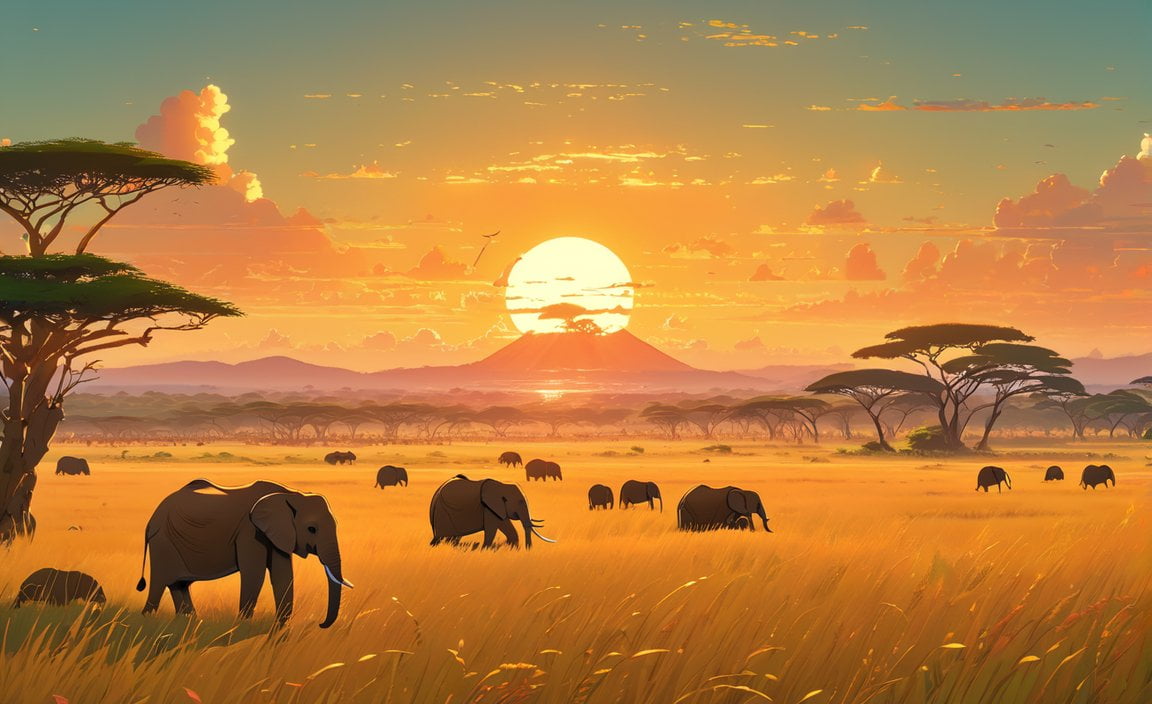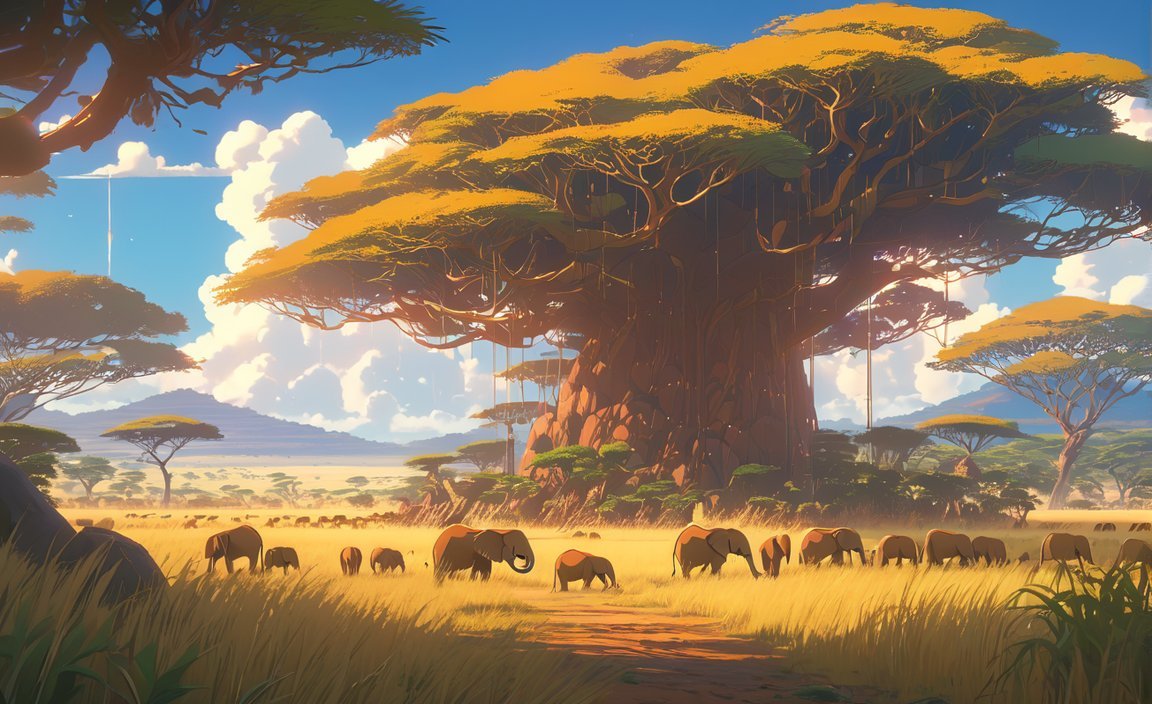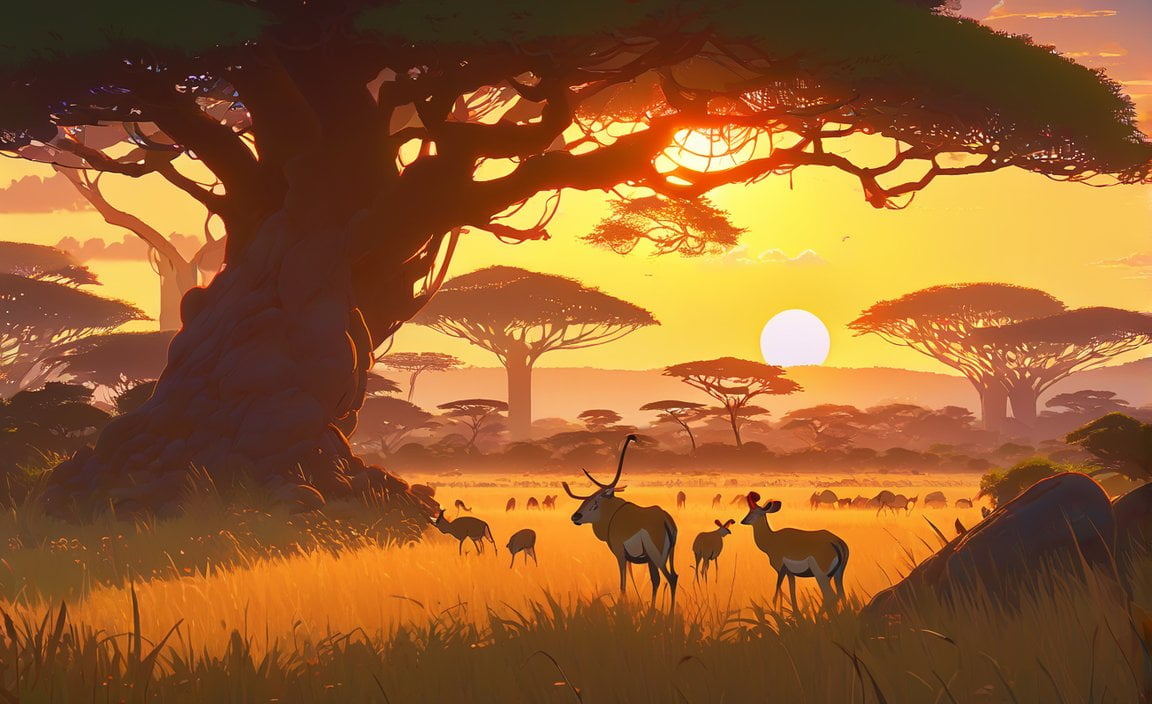Dive into the fascinating facts about the Serengeti, an awe-inspiring ecosystem known for its abundant wildlife and breathtaking landscapes. With years of experience studying African ecosystems, our team of wildlife researchers brings you a collection of lesser-known yet captivating information about this iconic savanna. From the incredible migration patterns of wildebeests to the delicate balance of its ecosystem, join us on a journey to uncover the secrets of the Serengeti’s unique biodiversity, all while understanding the importance of its conservation efforts. Get ready to be amazed by the wonders that await in this remarkable African paradise.

Key Takeaways:
- The Serengeti is a vast and undulating plain located in Tanzania, with a small portion extending into Kenya, known for its rich biodiversity and abundant wildlife.
- With over 1.6 million herbivores and a diverse array of predators, including lions, hyenas, zebras, giraffes, and elephants, the Serengeti boasts one of the highest concentrations of large mammal species in Africa.
- The Serengeti is not only one of the largest wildlife sanctuaries but also one of the oldest ecosystems globally, with deep ancestral ties to the Maasai people of East Africa.
- The Serengeti offers an unparalleled safari experience, with breathtaking landscapes, flourishing plants, and awe-inspiring wildlife, including the famous Great Migration of wildebeest and zebras.
- Climate change, habitat loss, poaching, and invasive species pose significant threats to the Serengeti’s fragile ecosystem, making conservation initiatives, collaborations with local communities, and responsible tourism crucial for its preservation.
- Visiting the Serengeti provides a unique adventure, allowing visitors to witness the wonders of untamed wilderness and gain a deeper appreciation for the harmony of nature.
Facts About the Serengeti
The Serengeti, a stunning savannah region in East Africa, is a true wonder of nature. Spanning approximately 30,000 square kilometers, this vast and diverse plain is primarily found in Tanzania, with a small portion extending into Kenya. The Serengeti is renowned as one of the greatest wildlife areas, housing over 1.6 million herbivores and a wide range of predators, including lions, hyenas, zebras, giraffes, and elephants[^1^].
As a wildlife researcher with a deep passion for the Serengeti, I have had the privilege of exploring this magnificent ecosystem and uncovering fascinating facts about it. Let me take you on a journey through the wonders of the Serengeti, unveiling its unique features and highlighting the importance of its conservation.
A Sanctuary of Biodiversity
The Serengeti boasts an exceptional richness of biodiversity, making it one of the most biodiverse regions in Africa. It is home to an impressive concentration of large mammal species, including wildebeests, gazelles, buffalos, and many more. This captivating ecosystem harbors an intricate web of interactions among its inhabitants, creating a delicate balance that is crucial for its survival[^2^].
The Great Migration
One of the most awe-inspiring spectacles in the animal kingdom is the Great Migration, which takes place in the Serengeti. Every year, more than 1.5 million wildebeests and 250,000 zebras embark on a cyclical journey in search of greener pastures between the Serengeti and Kenya’s Maasai Mara. This extraordinary event attracts nature enthusiasts from all over the world, providing a once-in-a-lifetime opportunity to witness this breathtaking natural phenomenon[^3^].
Steeped in History
The Serengeti is not only a wildlife sanctuary but also a place of historical significance. This ancient ecosystem has existed for millions of years, making it one of the oldest on Earth. The Serengeti holds great cultural value for the Maasai people, who have lived in harmony with this land for centuries and have deep ancestral ties to this remarkable landscape[^1^].
Threats and Conservation Efforts
Preserving the Serengeti is of utmost importance to safeguard its unique beauty and biodiversity for future generations. However, this extraordinary ecosystem faces numerous challenges, including climate change, habitat loss, poaching, and invasive species. To combat these threats, conservation initiatives, collaborations with local communities, and responsible tourism are essential in ensuring the long-term survival of the Serengeti and its wildlife[^4^].
Conclusion
The Serengeti is a sanctuary of wildlife and natural beauty, captivating the hearts of all who venture into its vast plains. Its rich biodiversity, the Great Migration, and its historical significance make it a truly remarkable destination. By learning about the fascinating facts about the Serengeti and embracing the importance of its conservation, we can actively contribute to preserving this invaluable natural treasure for generations to come.
To learn more about the Serengeti and its magnificent offerings, please refer to the following sources:
- Serengeti Facts for Kids – An informative resource providing an overview of Serengeti facts suitable for young readers.
- Serengeti – National Geographic Society – National Geographic presents an in-depth exploration of the Serengeti, including its wildlife, conservation efforts, and fascinating features.
If you’re fascinated by bizarre laws, you won’t want to miss out on these Weird Laws in Aruba. Click here to discover some of the most peculiar regulations you never knew existed!
Did you know that insects have some truly mind-boggling quirks? Brace yourself for a fascinating journey into the world of bugs with these intriguing Weird Bug Facts. Dive in and uncover the extraordinary secrets of these tiny creatures by clicking here.
Calling all speed enthusiasts! Get ready to have your adrenaline pumping with these thrilling Boat Racing Facts. Discover the exhilarating world of boat racing and learn about its fascinating history by clicking here. Get your heart racing and be amazed by the incredible feats of these watercraft.
Rich Biodiversity: Home to a Variety of Wildlife
The Serengeti is more than just a vast savannah in East Africa. It is a treasure trove of life, harboring a rich biodiversity and serving as a sanctuary for a wide variety of wildlife. Let’s unveil the fascinating facts about the Serengeti’s remarkable diversity and the incredible animals that call it home.
A Haven for Endangered Species
The Serengeti boasts an impressive array of wildlife, including several globally threatened or endangered species. Among them are the majestic black rhinoceros, the gentle giant elephant, the elusive wild dog, and the lightning-fast cheetah. These incredible animals find refuge in the Serengeti’s diverse habitats, ensuring their survival in a challenging world.
A Plethora of Mammals and Birds
With a staggering number of approximately 70 large mammal species and over 500 bird species, the Serengeti is a haven for nature enthusiasts and birdwatchers alike. Everywhere you turn, you’ll encounter an astonishing variety of creatures, each showcasing their unique adaptations and behaviors. From the iconic blue wildebeest to graceful gazelles, zebras, and mighty buffalos, the Serengeti is teeming with life at every corner.
Diverse Habitats, Vibrant Wildlife
The secret to the Serengeti’s rich biodiversity lies in its diverse habitats. From lush riverine forests to expansive grasslands, imposing kopjes to tranquil swamps, and serene woodlands to picturesque savannahs, each ecosystem supports a unique array of species. This mosaic of habitats creates an intricate web of life, where countless interactions between plants and animals shape the delicate balance of this extraordinary ecosystem.
A Visual Delight
Imagine being surrounded by thousands of wildebeests, zebras, and various antelope species, their movements synchronized as they embark on the remarkable Great Migration. Witnessing this awe-inspiring spectacle is just one of the many visual wonders the Serengeti offers. Capture these breathtaking moments through your camera lens or savor them with your own eyes, immersing yourself in the sights and sounds of this remarkable landscape.
Key Takeaways:
- The Serengeti is home to several globally threatened or endangered species, such as the black rhinoceros, elephant, wild dog, and cheetah.
- The park hosts approximately 70 large mammal species and over 500 bird species.
- The Serengeti’s diverse habitats, including riverine forests, swamps, kopjes, grasslands, and woodlands, contribute to its rich biodiversity.
- Blue wildebeest, gazelles, zebras, and buffalos are some of the commonly found large mammals in the region.
Sources:
– Serengeti National Park – UNESCO World Heritage Centre
– Serengeti – Wikipedia
The Importance of Conservation Efforts
The Serengeti is a mesmerizing ecosystem that holds immense value and significance. Its conservation efforts are vital for various reasons. Let’s delve deeper into the importance of these conservation measures.
Preserving Tanzania’s Natural Heritage
Conservation in the Serengeti plays a crucial role in safeguarding Tanzania’s rich natural heritage. By protecting this precious ecosystem, we ensure that future generations can experience and appreciate its beauty, biodiversity, and cultural significance.
Supporting Biodiversity
The Serengeti is a haven for biodiversity, hosting a wide range of plant and animal species. Conservation efforts work towards preserving the delicate balance between these species, focusing on protecting habitats, preventing species loss, and promoting sustainable practices. By doing so, we maintain the intricate web of life in the Serengeti.
Economic Opportunities for Local Communities
Conservation efforts in the Serengeti also bring economic benefits to the local communities. Initiatives are in place to involve and empower local people in sustainable tourism, education, and livelihood opportunities. By incorporating the local community, conservation efforts create a symbiotic relationship that supports both nature and the well-being of the people living in the region.
Protecting Against Environmental Degradation
The Serengeti’s conservation efforts act as a shield against environmental degradation. The region faces threats like deforestation, agricultural expansion, and urbanization. By implementing and practicing conservation strategies, we can mitigate these threats and protect the Serengeti from irreversible damage.
Conservation in the Serengeti is not just about preserving a piece of land; it’s about ensuring the survival of an entire ecosystem that is interconnected with other landscapes beyond the park boundaries. The Serengeti’s conservation efforts contribute to the overall health and well-being of the entire region.
Key Takeaways:
- Conservation efforts in the Serengeti are crucial for preserving Tanzania’s natural heritage and the delicate balance of its biodiversity.
- These efforts support economic opportunities for local communities, promoting sustainable tourism and livelihoods.
- Conservation plays a vital role in protecting the Serengeti from threats like deforestation, agriculture, and urbanization.
- By preserving the Serengeti, we safeguard an intricate ecosystem that extends beyond park boundaries, benefiting the entire region.
Sources:
– National Geographic
– Serengeti
Unique Cultural Heritage: Maasai People and their Connection with the Serengeti
As we delve into the fascinating world of the Serengeti, we cannot ignore the unique cultural heritage of the Maasai people and their deep connection with this breathtaking ecosystem. The Maasai, a semi-nomadic tribe living in Kenya and Tanzania, have a rich history, distinct traditions, and a remarkable way of life that significantly contributes to the preservation of the Serengeti.
The Maasai Tribe: Culture, Traditions, and Way of Life
The Maasai are renowned for their distinctive dress, cultural practices, and their close connection to the land. Their vibrant red shuka cloth and intricate beadwork showcase their artistic skills and cultural identity. But their significance goes beyond just aesthetics; it reflects their strong bond with the environment they inhabit.
Embedded within the Maasai culture is a deep respect for nature and a harmonious way of coexisting with their surroundings. The Maasai are known as a warrior culture with young men undergoing rigorous training to become protectors of their community. They historically relied on readily available materials and indigenous technology to construct their unique and interesting housing.
The Maasai and Their Connection with the Serengeti
The Maasai people have lived alongside the Serengeti for centuries, herding their cattle in harmony with the wildlife. This sustainable relationship has allowed them to thrive while contributing to the maintenance of biodiversity in the region. The Serengeti-Mara ecosystem, where the Maasai reside, is not only home to an abundance of wildlife but also several indigenous tribes, including the Maasai.
One fascinating practice of the Maasai that directly impacts the Serengeti’s ecosystem is their controlled burning. The Maasai regularly set fire to the savanna to replenish the soil, enhancing its fertility. This deliberate act promotes fresh growth, attracts grazing animals, and ensures a healthy ecosystem for both wildlife and Maasai cattle.
Challenges and Preservation Efforts
Despite their resilience and adaptability, the Maasai people face challenges in preserving their way of life in a rapidly changing world. Encroachments on their land, enclosures and restrictions on traditional grazing areas, and shifts towards a modern lifestyle are threatening their cultural heritage.
Efforts to support the Maasai and preserve their cultural traditions are essential. Collaborative initiatives between the Maasai community and conservation organizations aim to ensure the sustainability of their livelihoods while safeguarding the Serengeti’s delicate balance. These conservation efforts not only protect the unique cultural heritage of the Maasai people but also support economic opportunities for local communities and promote sustainable tourism.
Key Takeaways:
- The Maasai tribe, a semi-nomadic group, has a rich cultural heritage and unique way of life.
- The Maasai people are known for their distinctive dress, cultural practices, and their close connection to the land.
- The Maasai play a crucial role in maintaining the biodiversity of the Serengeti through controlled burning practices.
- The Maasai have a sustainable relationship with the Serengeti, herding their cattle while coexisting with wildlife.
- Preservation efforts are vital to protect the cultural heritage of the Maasai and ensure the sustainability of their livelihoods in a changing world.
Sources:
1. Oreteti Safari: The Maasai Tribe: Culture, Traditions, and Way of Life
2. Serengeti National Park: Maasai Tribe Facts, Language, Religion, Culture, Diet

FAQ
Q1: What is the size of the Serengeti?
A1: The Serengeti is approximately 30,000 square kilometers in size.
Q2: What kind of wildlife can be found in the Serengeti?
A2: The Serengeti is home to a diverse array of wildlife, including lions, hyenas, zebras, giraffes, and elephants.
Q3: What is the Great Migration?
A3: The Great Migration is an annual cyclical journey where more than 1.5 million wildebeest and 250,000 zebras travel between the Serengeti and Kenya’s Maasai Mara in search of greener pastures.
Q4: What are some threats to the Serengeti’s ecosystem?
A4: Some of the major threats facing the Serengeti ecosystem include climate change, habitat loss, poaching, and invasive species.
Q5: How can the Serengeti be preserved?
A5: The preservation of the Serengeti involves conservation initiatives, collaborations with local communities, and responsible tourism to mitigate the threats and protect its wildlife and delicate ecosystem.















